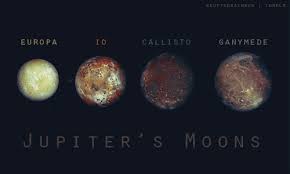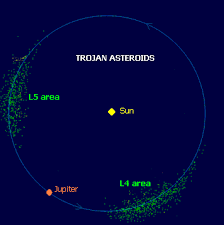Overview
The planet Jupiter, besides being the largest planet in the Solar System, has over 65 moons discovered so far. It also has very faint rings. Numerous asteroids, called Trojans, share the same orbit around the Sun with Jupiter.
The Galilean Moons
The four largest moons of Jupiter were observed by Galileo in 1610 through his telescopes. He named them in honor of the Medici family, his patrons and the rulers of Venice at the time. They were renamed Io, Europa, Ganymede, and Callisto by other astronomers later in the 1600s, to conform to mythological names that are used for other astronomical objects. However, those names were not used extensively until the 20th century. Io is the closest moon to Jupiter, and has over 400 active volcanoes, making it the most geologically active object discovered in the Solar System. Many of them erupt clouds of sulfur and sulfur dioxide that later become part of Jupiter’s atmosphere. It has a molten iron sulfide core, surrounded by silicate rock. Europa, in contrast, has a layer of ice surrounding an iron core and silicate rock. Scientists believe that under the layer of water ice, it may have deep-water oceans that move similarly to tectonic plates on Earth. They move with the tides created by the gravitational attraction from Jupiter. Ganymede, at twice the mass of Earth’s Moon, is the largest natural satellite in the Solar System, and is larger than the planet Mercury. Like Europa, it has a molten core, a silicate mantle, and probably an ocean made of water under a water ice crust. Callisto is the most remote of the Galilean moons, and possibly has a rocky core, with equal parts of water ice and rock surrounding the core. Its surface is heavily cratered, with most features created by impact craters.
Smaller Moons
The next moon of Jupiter, Amalthea, was not discovered by telescope until the late 19th century. Eight others were discovered as telescopes became stronger, in the first half of the 20th century. During explorations by Voyager, Galileo, and other space probes, still more small moons were found. Some may be asteroids captured from their orbits by the strong gravitational fields from Jupiter.
Jupiter’s Surprising Rings
Rings around Jupiter were observed by the Voyager probes in the late 1970s, the Galileo orbiter in the 1990s, the Hubble Space Telescope, and the strongest telescopes on Earth. Unlike the more familiar rings around Saturn that are made mostly of ice, these rings are made of dust particles ejected when Jupiter’s moons are impacted by asteroids, comets, and other debris. The rings are divided into 4 separate sections, and they may have existed since Jupiter was first formed.
Trojan Asteroids
Asteroids that share the same orbit as Jupiter but do not orbit Jupiter are called Trojan asteroids. They are trapped in the orbit of Jupiter because they are always 60 degrees ahead of it in orbit or 60 degrees behind it. These theoretical Lagrange points were hypothesized by astronomers in the late 1700s, but they were not observed until the 20th century, until telescopes were strong enough to pick up small, faraway objects close to the planet Jupiter. There are estimated to be over 6000 of them, similar in size and composition to asteroids in the main belt.
Interested in science tutoring services? Learn more about how we are assisting thousands of students each academic year.
SchoolTutoring Academy is the premier educational services company for K-12 and college students. We offer tutoring programs for students in K-12, AP classes, and college. To learn more about how we help parents and students in Crete, NE: visit Tutoring in Crete, NE




